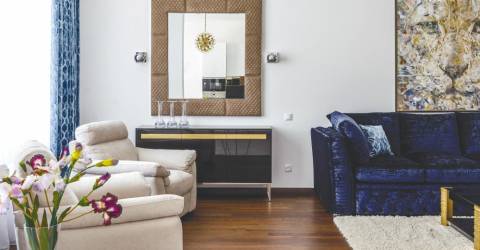Have you ever walked into a room and been surprised to see how much bigger the space looked with a good mirror? By reflecting light around the room, mirrors can amp up spaces by providing it with more dimension and depth. Even the ancient Chinese practice of feng shui tells how important mirrors are for a space to achieve harmony with its environment.
As one of the underrated interior decor pieces, mirrors are an easy way to accentuate the beauty of your space while making the most out of it, so here are some tips when choosing and placing a mirror in your space.
The detail is in the placement
The placement of the mirror is in conjunction with what it reflects, and greatly influences the visual appeal of the space. A mirror that reflects a sloping ceiling or a rubbish bin won’t be the most flattering sight to behold, so use mirrors to deflect attention away from any awkward or unpleasing spots in the room.
Instead, place it thoughtfully to emphasise the plus points of the room. When placed strategically, it can also become a statement piece in a room that is too small for another piece of furniture.
Keep it eye level
Although you might want to draw the eye upward to make ceilings appear higher, you don’t want people craning their necks to look into the mirror. Unless you’re hanging a mirror over a headboard or a mantle, the sweet spot for placement is at the average person’s eye level, which is roughly 150cm from the floor to the centre of the mirror. If you have any artwork around the room, make sure to hang them at the same height to have a continuous line to tie the space together.
Besides that, make sure that there isn’t too much clutter near the mirror and that it isn’t placed too far from a furniture piece. Otherwise, it will make the space look messier and more disconnected.
Focus on me
In interior design 101, a room tends to look dull and uninteresting without a focal point, which is one of the most fundamental elements in interior design. Put simply, it’s the star of the room. It’s the first place viewers’ eyes would land on when they enter the room and it’s the emphasis point around which you build the rest of your design.
Essentially, a bare room can benefit from a mirror as its architectural focal point. A large mirror with an extensive frame can offer drama and playfulness to the room, while a round mirror can better achieve a more modern and distinct look. When it comes to decorative art, mirrors with unique and eccentric frames can reasonably substitute for paintings. So it would be a smart move to invest in a lavish mirror to exude elegance, luxury, and style, or perhaps one with golden or metallic detailing to give off a vintage vibe.
Let there be light
To increase the amount of natural light, all you need to do is place a mirror opposite or beside a window. No matter how gloomy the sky is outside, it will harness any available daylight and shine it right into the room to brighten up the place.
Besides that, you can also bring the spectacle of the outdoors into your home by arranging mirrors on a wall opposite a picture window. The mirrors will reflect the picturesque view of a seascape scenery, cottage garden, majestic mountain ranges or whatever scenery you enjoy through a favourite window in your home.
Moreover, it’s not just natural light that can be manipulated this way. Mirrors effectively emphasise other light sources as well, so if your room feels a little cavernous or dark, try placing a mirror near a table lamp and you’d be amazed how much of a difference it’d make.
The bigger the better
To maximise a mirror’s impact, consider a large mirror. When you go a little bit larger, it creates more drama in the room, continues the line of vision, and ends up visually expanding the space. To open up a small, cramped bathroom, you can try installing floor-to-ceiling mirrors that will help draw the eye upward to create the illusion of sky-high ceilings.
When positioning a mirror over a piece of furniture, it should expand upward instead of being wider than the furniture. A tip is for larger mirrors: make sure to stick with a fairly simple frame as an ornate frame might hamper your goal of making the place feel bigger.
